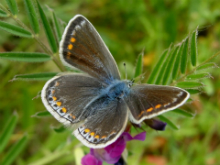
| Butterfly Conservation |
 |
| Hertfordshire & Middlesex Branch |
 |
|
|||
| Saving butterflies, moths and our environment | ||||
%20030814_DM_43.jpg)

Common BluePolyommatus icarusWidespread and common Distribution and Status The Common Blue is widespread and common in our branch area although it is absent from the some of the more urban and agricultural areas. Although populations are a little lower than 30 years ago it is colonising new sites after a lean spell at the turn of the century. 2018 saw substantial increases in numbers at many locations Habitat Requirements Open grassy areas especially where the larval foodplant Common Bird's-foot Trefoil Lotus corniculatus grows Larval Foodplants Common Bird's-foot Trefoil L. corniculatus. Other plants such as Greater Bird's-foot Trefoil L. uliginosis on wetter soils, Lesser Yellow Trefoil Trifolium dubium, Black Medick Medicago lupulina and Common Restharrow Ononis repens have also been recorded Adult Food Sources Common Bird's-foot Trefoil L. corniculatus, Garden Lavender Lavandula x intermedia, Heather Calluna vulgaris, Thistles Cirsium sp. Behaviour/Observation notes The female Common Blue can look very much like a Brown Argus. Aside from the different spot patterns on the undersides for the two species, the best way to distinguish between them, another clue is the flight behaviour. Brown Argus is usually more skittish and appears silvery-grey whereas the female Common Blue makes slow flights between resting/nectaring and looking for places to lay her eggs Life History There are two broods every year with the second generation usually seen in greater numbers. Peak numbers are often recorded in the last week of May and first week of June for the first brood, and early to mid August for the second generation. In warm years there may be a partial third generation as occurred in 2018. Females lay eggs on the leaves on which the caterpillars feed underneath. Larvae attract the attention of ants when fully grown. Pupae are formed on the ground, sometimes close to ants' nests. The butterfly overwinters in the larval stage Further information
UK distribution map |
Copyright Butterfly Conservation © 2019 Hertfordshire & Middlesex Branch
Privacy and Copyright Statement and Cookie Policy Statement
Butterfly Conservation
Company limited by guarantee, registered in England (2206468)
Registered Office: Manor Yard, East Lulworth, Wareham, Dorset, BH20 5QP. Tel: 01929 400 209
Charity registered in England & Wales (254937) and in Scotland (SCO39268). VAT No. GB 991 2771 89